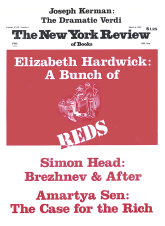In response to:
Death in the Philippines from the December 17, 1981 issue
To the Editors:
Gore Vidal was closer to the truth than he realized when he suggested [NYR, December 17] that Moorfield Storey may have looked at an early edition of the May 3, 1901 New York Times and that that is why others have not been able to find the quote Storey attributes to General Bell.
Since the Times microfilms only the late edition, an article seen by Storey in an early May 3 paper would appear on the microfilm for the day before. And, sure enough, there on page one of the May 2, 1901 Times is the story with Bell stating that “One-sixth of the natives of Luzon have either been killed or have died of the dengue fever in the last two years.”
One of Vidal’s correspondents argues that Bell was singled out for criticism for his brutality. But as John M. Gates (another letter writer) has shown in his apologia for US tactics in the Philippines, Schoolbooks and Krags (Greenwood, 1973), “both civil and military officials in the Philippines” considered that “Bell’s campaign in Batangas represented pacification in its most perfected form (p. 288).”
To be sure, Bell was only guessing at the death figures. The subsequent census reported that in Batangas in 1902 the death rate was 132.9 per thousand, or one out of eight. For the Philippines as a whole, the census gave a 1902 death rate of one out of sixteen—twice the normal rate. Over the course of the Philippine-American war, perhaps 10 percent of the population died.
To Gates, US policy was a model of “benevolent pacification.” With a 10 percent death toll, there must be an adjective more accurate than “benevolent.” Vidal’s characterization of US policy as genocidal seems much more on the mark.
Stephen Rosskam Shalom
William Paterson College
Wayne, New Jersey
This Issue
March 4, 1982



